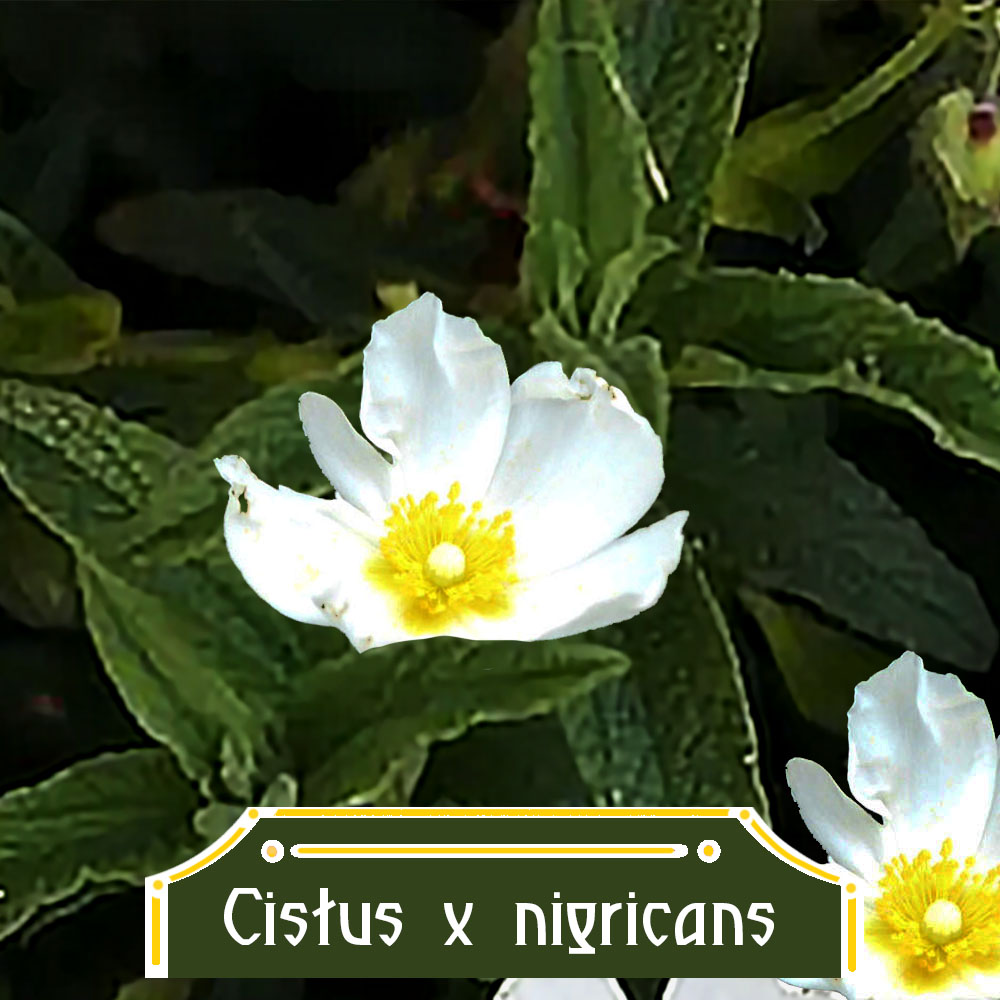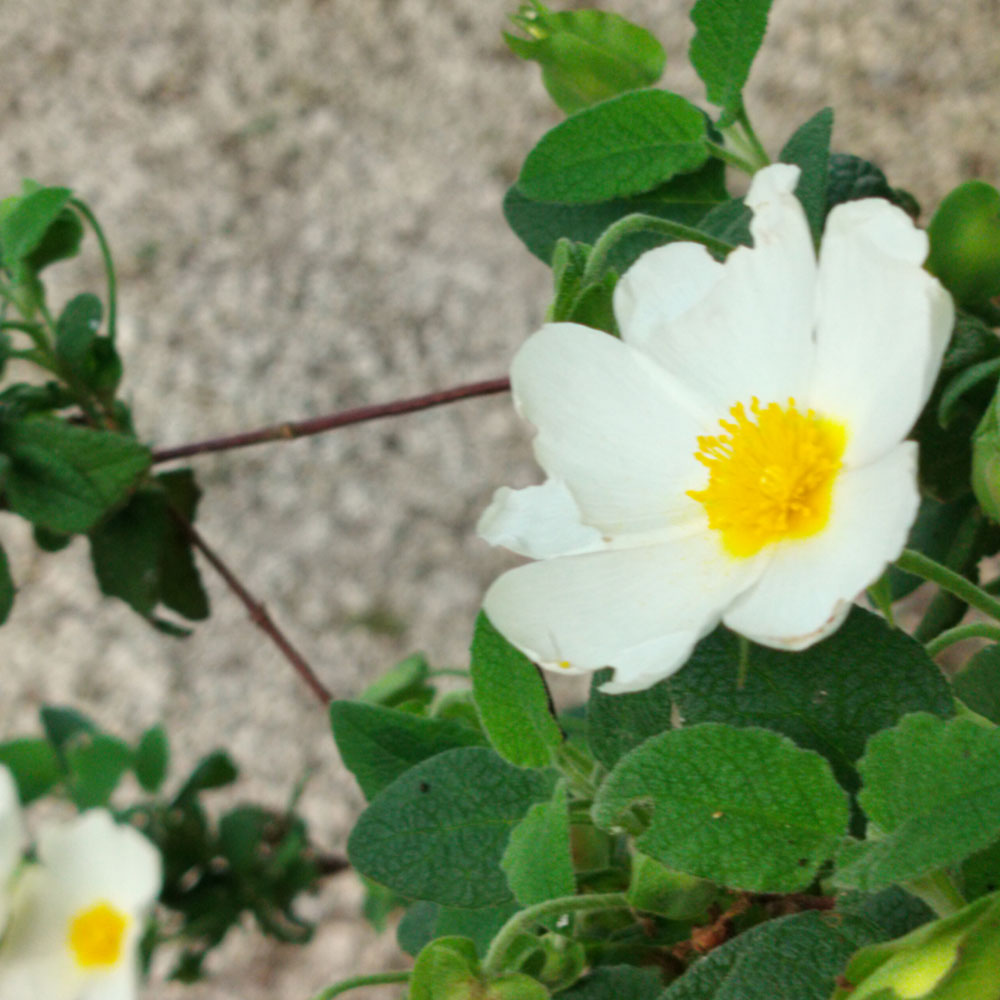No products in the cart.
Cistus nigricans
A bush with dark green fragrant leaves that smell of summer
Rated 0 out of 5
0 customer reviews
4,90 € – 15,00 €Price range: 4,90 € through 15,00 €
Tags: couleur, graphique, secheresse, vivace, vivace en pot, xeriscaping
SKU: pda260
Category: Bees and Butterflies, Bouquet, Distillations, Evergreen, Fragrant, Frost Hardy, Ground Cover, Medicinal, Rewild, The Stunners

Cistus nigricans
4,90 € – 15,00 €Price range: 4,90 € through 15,00 €
Cistus nigricans (Cistus x nigricans) is a compact evergreen Mediterannean shrub with lightly fragrant foliage and a charming show of little white flowers in the spring.
The leaves are evergreen, hairy, sometimes quite sticky. Because it is a hybrid, it has a leaf form that is between lance-shaped and rounded.
The flowers bloom in spring and last only a day, but new ones open daily, creating a lovely carpet of fallen petals.
The bloom time is a bit longer than other varieties of ciste – notably the Cistus monspeliensis
It flourishes in gravelly soils or when planted among rocks, as well as in sunny flower beds and borders.
👨🌾GARDENING TIPS👨🌾:
-
- ✂️ Cistus can be lightly pruned after flowering and pinched back to promote a bushy growth, but avoid cutting into old wood.
- 🪰 Their thick leaves + resin do not attract pests, though their delicate flowers can be damaged by heavy rain
- 🏠 Avoid transplanting them once they are settled, as their roots do not like to be disturbed.
🌱🌿pdA Garden Buddy Suggestions🌱🌿 :
Learn more about Gardening with the Cistus family:
The Tales & The Botany of Cistus nigricans:
Cistus x nigricans is a cultivated hybrid, most often a cross between Cistus crispus and Cistus salvifolius
The genus Cistus was named by French botanist Joseph Pitton de Tournefort, derived from the Greek Kistos, which was later Latinized as Cisthos by Pliny the Elder. The genus includes around twenty Mediterranean shrub species in the Cistaceae family, closely related to Halimium and Helianthemum.
These plants have opposite, evergreen to semi-evergreen leaves that are oval to lanceolate, sometimes elongated. Some species, like Cistus ladanifer, contain aromatic resin used to produce medicinal labdanum.
Labdanum is a sticky brown resin extracted from the Cistus plants that is still used to produce perfume and vermouth. You’ll see when you touch the plant, it’s quite sticky.
🔥 Their fruits are fire-resistant capsules, allowing them to reseed naturally after a wildfire.
🥷 They also suppress weed growth through allelopathy (releasing substances that inhibit weed germination) something that our friends in the Thyme family are infamous for.
🌸 Floral Morphology of Cistus nigricans
Members of the Cistaceae, including the genus Cistus, typically produce solitary or cymose inflorescences with showy, crêpe-like petals.
Flowers are actinomorphic (characterized by radial symmetry), pentamerous, and range from 2 to 8 cm in diameter depending on species. Petals are usually white, pink, or purple with conspicuous yellow stamens. Sepals (3–5) are persistent and may be hairy or glabrous.
Leaves are opposite, simple, entire, and often covered with glandular trichomes secreting aromatic resins such as labdanum. This resin imparts drought resistance and fragrance.
🌱 Reproductive Biology
Flowers are hermaphroditic, often protandrous (anthers mature before stigmas), which encourages cross-pollination. Despite this, many species retain a level of self-compatibility, ensuring reproduction under low-pollinator conditions.
Pollination is predominantly entomophilous, with bees, beetles, and flies visiting for pollen rather than nectar.
Seeds are borne in dehiscent capsules containing numerous small seeds adapted for germination after disturbance (particularly fire).
🌍 Ecology & Adaptations
Cistaceae are emblematic of Mediterranean-type ecosystems on poor, rocky soils. Key adaptations include:
-
-
High Drought tolerance via resinous, sclerophyllous (a sclerophyll is a type of vegetation that is adapted to long periods of dryness and heat) leaves.
-
Fire-related regeneration, with seeds requiring heat shock or smoke compounds to germinate.
-
Symbiosis with mycorrhizal fungi (notably Tuber spp.), which enhance nutrient uptake in low-fertility soils.
-
Other Names:
Rockrose
Origin:
France
| Weight | 0,5 kg |
|---|---|
| Container Size | 9×9 cm, 2L |
| Flower Color | ⚪ White |
| Flowering | April, May |
| Soil | Dry, Poor, Sandy, Well-Draining |
| Exposure | Full Sun |
| Frost Tolerance | -10°C to -15°C |
| Size | 1.5m H x 0.7m W |
| Planting Season | March to May, May to August |
Reviews
0
Rated 0 out of 5
0 customer reviews
5
0
4
0
3
0
2
0
1
0
Only logged in customers who have purchased this product may leave a review.
Related Products
Kalanchoe daigremontiana
A toothy succulent from Madagascar, known as the Mother of Thousands.
A toothy succulent from Madagascar, known as the Mother of Thousands.
Rated 0 out of 5
Delosperma cooperi
A dwarf perennial known for its vermillion colored flowers
A dwarf perennial known for its vermillion colored flowers
Rated 0 out of 5
Tanacetum densum subsp amani
A shrublet composed of soft, finely divided silvery gray-white leaves.
A shrublet composed of soft, finely divided silvery gray-white leaves.
Rated 0 out of 5
Glechoma hederacea
A sweet smelling ground cover, producing little blue flowers all summer long.
A sweet smelling ground cover, producing little blue flowers all summer long.
Rated 0 out of 5
Hellebore argutifolius
Winter flowering perennial with marbled blue-green leaves
Winter flowering perennial with marbled blue-green leaves
Rated 0 out of 5
Erigeron kavinskianus
A daisy-like carpet of flowers
A daisy-like carpet of flowers
Rated 0 out of 5
Artemisia Valerie Finnis
A semi-evergreen, aromatic variation on the theme of Artemisia.
A semi-evergreen, aromatic variation on the theme of Artemisia.
Rated 0 out of 5
Mentha x piperita ‘Chartreuse’
A spicy mint, known for its use in the production of liqueurs and herbal teas.
A spicy mint, known for its use in the production of liqueurs and herbal teas.
Rated 0 out of 5
Trachelospermum asiaticum ‘Ogon Nishiki’
Jasmine with colorful foliage and lovely white flowers in summer
Jasmine with colorful foliage and lovely white flowers in summer
Rated 0 out of 5
Stachys byzantina
Silky white-grey leaves and tall striking flowers
Silky white-grey leaves and tall striking flowers
Rated 0 out of 5
Tradescantia Blushing Bride
Gorgeous blushes of pink and white that appear in the coldest nights.
Gorgeous blushes of pink and white that appear in the coldest nights.
Rated 0 out of 5
Vinca minor
Looping elegance and ability to form a low flowering ground cover
Looping elegance and ability to form a low flowering ground cover
Rated 0 out of 5
Euphorbia cyparissias Clarice Howard
A Euphorbia that resembles a soft little cyprus tree
A Euphorbia that resembles a soft little cyprus tree
Rated 0 out of 5
Cerastium tomentosum var. columnae
A grey-green spreading ground cover from the mountains.
A grey-green spreading ground cover from the mountains.
Rated 0 out of 5
Hieracium maculatum Leopard
A native perennial with blue-green leaves and a tall yellow flower
A native perennial with blue-green leaves and a tall yellow flower
Rated 0 out of 5
Euphorbia myrsinites
Known for its draping form of silver-gray foliage and radiant blooms.
Known for its draping form of silver-gray foliage and radiant blooms.
Rated 0 out of 5
Echinacea purpurea
A perennial with purple flowers all summer long
A perennial with purple flowers all summer long
Rated 0 out of 5
Melissa officinalis
A perennial plant in the mint family that is adored by bees, royal families and tea drinkers.
A perennial plant in the mint family that is adored by bees, royal families and tea drinkers.
Rated 0 out of 5
recent view product
Erigeron kavinskianus
A daisy-like carpet of flowers
A daisy-like carpet of flowers
Rated 0 out of 5
Aster novi-belgii ‘Henri Picot’
Large clouds of bright blue flowers.
Large clouds of bright blue flowers.
Rated 0 out of 5
Centaurea montana
A perennial thistle with bright blue flowers atop silver green foliage
A perennial thistle with bright blue flowers atop silver green foliage
Rated 0 out of 5
Aptenia cordifolia Variegata
A succulent plant in the iceplant family with bright carmine flowers.
A succulent plant in the iceplant family with bright carmine flowers.
Rated 0 out of 5
Chrysanthemum Julie Lagravère
A perennial that produces many burgundy red flowers
A perennial that produces many burgundy red flowers
Rated 0 out of 5















































There are no reviews yet.